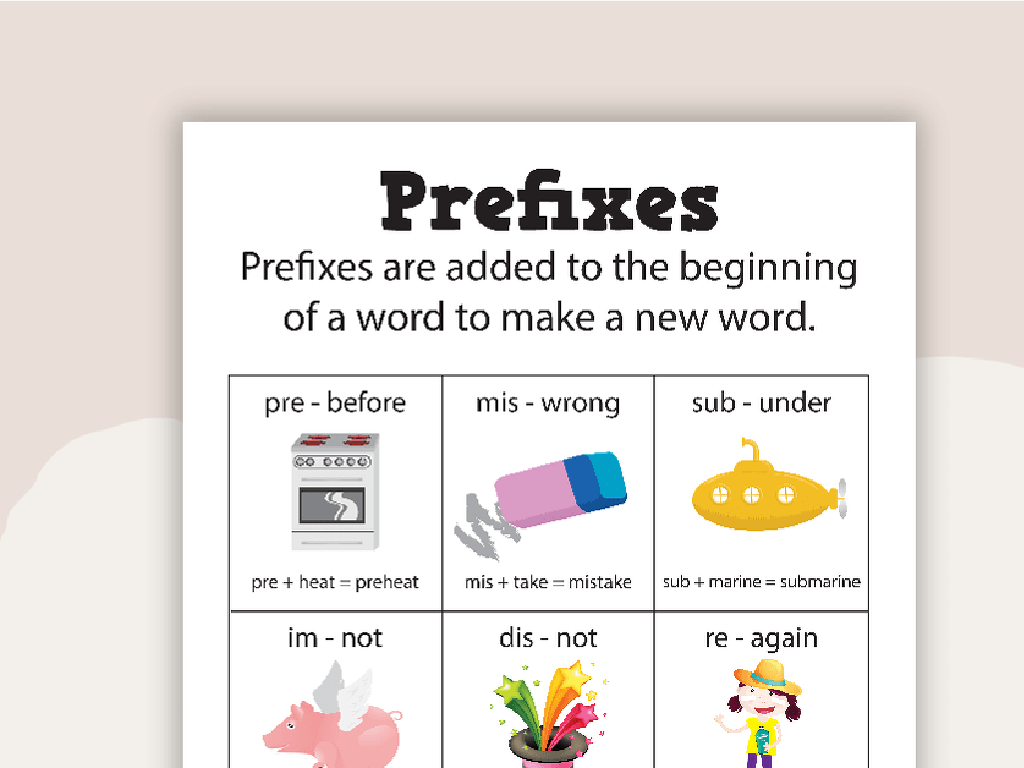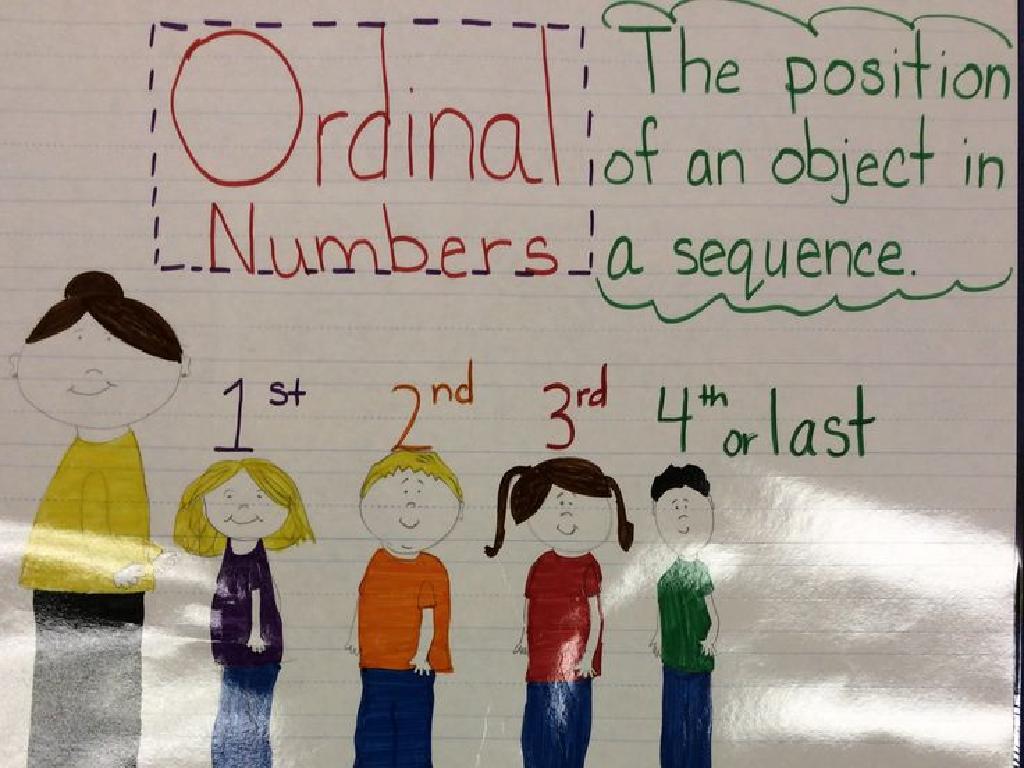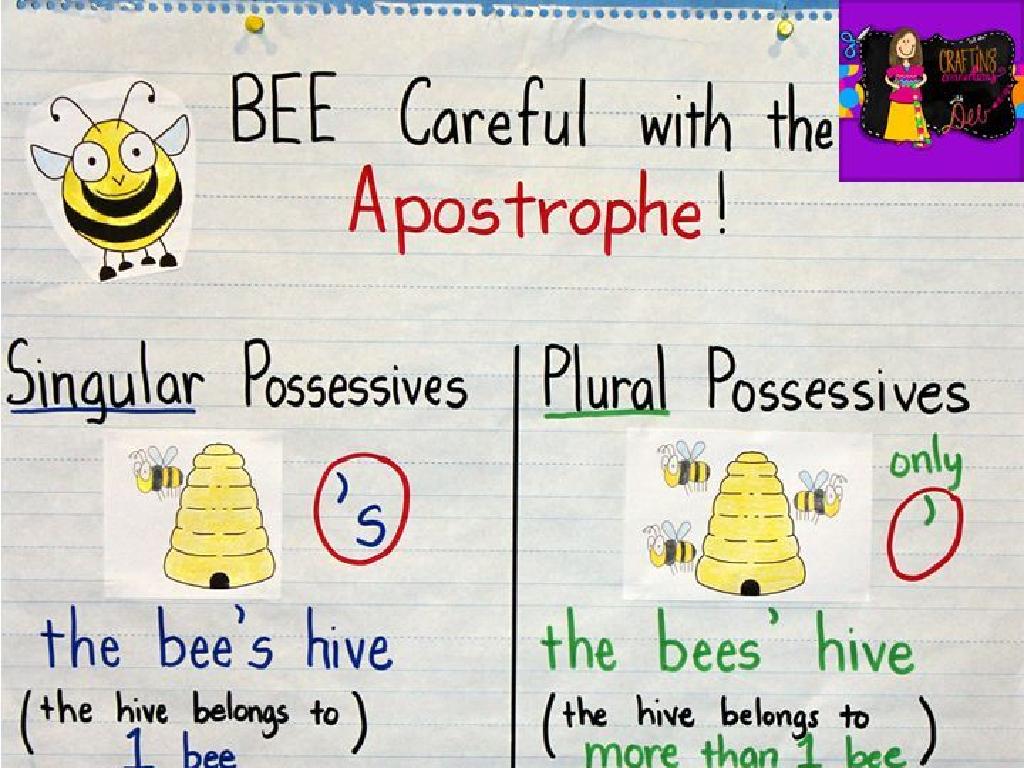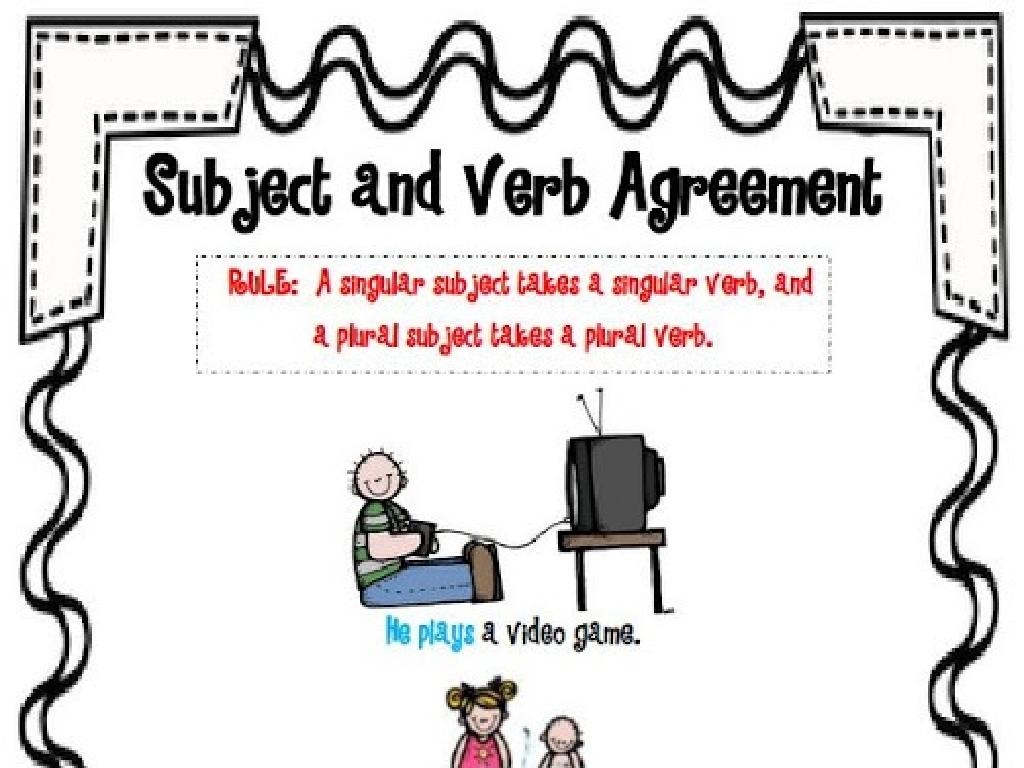Find The Next Shape In A Growing Pattern
Subject: Math
Grade: Kindergarten
Topic: Patterns
Please LOG IN to download the presentation. Access is available to registered users only.
View More Content
Welcome to Patterns!
– Greetings, young mathematicians!
– Today’s lesson: learning about patterns
– Patterns are sequences that repeat
– Patterns exist everywhere in life
– Examples: stripes on clothes, days of the week
– Recognizing and predicting patterns
– We’ll practice finding what comes next in a pattern
|
This slide is designed to introduce Kindergarten students to the concept of patterns, which is a fundamental part of early mathematical learning. Start the lesson with a warm greeting to make the children feel excited about the topic. Explain that patterns are sequences that repeat and can be found in many places in our daily lives, from the clothes we wear to the natural world around us. Use simple, relatable examples to illustrate patterns, such as the sequence of colors in a rainbow or shapes in a necklace. Encourage the children to observe and recognize patterns in the classroom or at home. The goal is to help them understand that patterns follow a rule, and once they figure out the rule, they can predict what comes next. This sets the stage for activities where they will identify and extend patterns on their own.
Exploring Patterns
– What is a pattern?
– A pattern repeats in a logical sequence.
– Patterns with colors and shapes
– Like red, blue, red, blue or circle, square, circle.
– Finding patterns around us
– Look for patterns in nature or at home.
– Practice spotting patterns
– We’ll look at examples and find the next part.
|
Introduce the concept of patterns to the students by explaining that a pattern is a sequence that repeats in a predictable way. Use simple examples like alternating colors or shapes to illustrate the idea. Encourage the children to observe their surroundings to find patterns, such as in floor tiles or clothing designs. Engage the class with interactive activities where they identify and continue patterns using classroom materials. This will help them understand the concept of patterns and prepare them for recognizing more complex patterns as they progress in math.
Exploring Patterns in Shapes and Colors
– Patterns are everywhere
– Patterns with colors and shapes
– Like red, red, blue or circle, square, circle
– Examples of simple patterns
– Red, blue, red, blue, what comes next?
– Finding the next part of a pattern
– What shape comes after square, circle, square?
|
This slide introduces the concept of patterns to Kindergarten students, focusing on visual patterns that they can recognize in their daily lives. Start by explaining that patterns are arrangements that repeat in a predictable manner. Show them simple examples of color and shape patterns, such as alternating colors or shapes. Use real-life examples like beads on a necklace or blocks in a tower. Encourage the students to observe and predict what comes next in a sequence. This activity will help develop their critical thinking and problem-solving skills. For the next class, prepare physical objects to create patterns that the students can interact with and arrange in sequences.
Creating Our Own Patterns
– It’s time to make a pattern!
– We’ll use blocks for an AB pattern
– Like red, blue, red, blue…
– Patterns repeat, watch them grow!
– See how the colors come again?
– What comes next? Let’s find out!
– Can you guess the next color?
|
This slide is designed to engage Kindergarten students in an interactive activity where they create their own patterns using physical blocks. The AB pattern is a simple alternating pattern, which is a great starting point for understanding the concept of patterns. Encourage the students to choose two different colors or types of blocks to create their AB pattern. As they build, remind them that patterns are all about repetition and predictability. Ask guiding questions to help them determine what comes next in the sequence they are creating. For the activity, have several examples ready, and consider grouping students so they can learn from each other. Possible variations for different students could include using stickers, drawing shapes, or arranging classroom objects into patterns.
Finding the Next Shape in Patterns
– Observe the pattern carefully
– Determine the repeating parts
– Patterns can repeat colors, shapes, or sizes
– Choose the shape that comes next
– It could be a circle, square, or triangle that fits
– Use what we know about patterns
– Remembering patterns we’ve seen in class
|
This slide is aimed at helping Kindergarten students understand the concept of identifying the next shape in a growing pattern. Start by encouraging the students to look at the pattern and observe its characteristics. Discuss the concept of repetition in patterns, such as how certain shapes or colors may repeat in a specific order. Guide them to use this knowledge to predict the next shape in the sequence. Provide examples of simple patterns and work through them together, then let the students try on their own with guidance. Reinforce learning by praising correct identification and gently correcting mistakes, always explaining the reasoning behind the pattern.
Growing Patterns in Shapes
– Patterns can ‘grow’
– Like a plant grows taller, some patterns add more parts
– Each step adds something new
– Maybe add a new circle or square each time
– Let’s explore a growing pattern
– We’ll look at examples together in class
– Practice finding the next shape
|
This slide introduces the concept of growing patterns to Kindergarten students. Explain that some patterns get bigger with each step, similar to how a plant grows. Show them a simple pattern, like a single shape that adds an additional shape in each step. Use visual aids to help them understand. For example, start with one circle, then show two circles, then three, and ask them what comes next. Encourage the students to think about what the next step in the pattern would be and how they can identify the rule that the pattern is following. Prepare several examples of growing patterns with different shapes and colors to make the activity engaging and to cater to different learning styles.
Practice Time: Finding the Next Shape
– Let’s practice patterns together
– Use your worksheets for puzzles
– Look at the shapes and see how they change step by step
– We’ll solve the first puzzle as a team
– I’ll help you with the first pattern, then you try!
– Finding the next shape is fun!
|
This slide is designed to engage Kindergarten students in a hands-on activity to reinforce their understanding of patterns. The worksheet will contain a series of pattern puzzles where students must determine what the next shape in the sequence should be. Start by demonstrating the process with the first puzzle, guiding the students through the pattern recognition. Then, allow them to attempt the subsequent puzzles independently or in small groups. Possible activities include: 1) Drawing the next shape on a whiteboard, 2) Using physical shape tiles to continue the pattern, 3) Circle the correct next shape from a choice of options, 4) Create their own pattern for a friend to solve. The goal is to make learning interactive and enjoyable while solidifying the concept of growing patterns.
Class Activity: Pattern Parade
– Let’s create a pattern parade
– Line up to make a body pattern
– Hold a shape to continue the pattern
– Each student adds to the pattern with their shape
– Observe the growing pattern
– What shape comes next? Let’s predict!
|
This activity is designed to help Kindergarten students recognize and predict patterns in a fun and interactive way. Have the children line up and give each of them a shape. They will use these shapes to create a pattern. As each child adds their shape to the pattern, the sequence will grow. Encourage the students to observe and predict which shape should come next. Possible shapes include circles, squares, triangles, and rectangles. This hands-on activity not only reinforces the concept of patterns but also helps with shape recognition. Make sure to assist and guide the students as they work on continuing the pattern correctly. After the activity, discuss with the class why the chosen shapes were the correct ones to continue the pattern.
Pattern Detectives: Great Work!
– Excellent pattern finding!
– Patterns help us predict
– Like guessing what comes next in a line
– Patterns organize our world
– Helps tidy up and sort objects
– Keep looking for patterns!
– You can find patterns in nature, at home, everywhere!
|
Congratulate the students on their hard work in identifying patterns and finding the next shape in a sequence. Emphasize the importance of patterns in making predictions and bringing order to the world around us. Encourage them to continue observing their environment for patterns, whether in nature, at home, or in their daily routines. This will not only reinforce their understanding of patterns but also spark their curiosity and engagement with the world around them. Remind them that being a ‘Pattern Detective’ is a fun and ongoing adventure.






